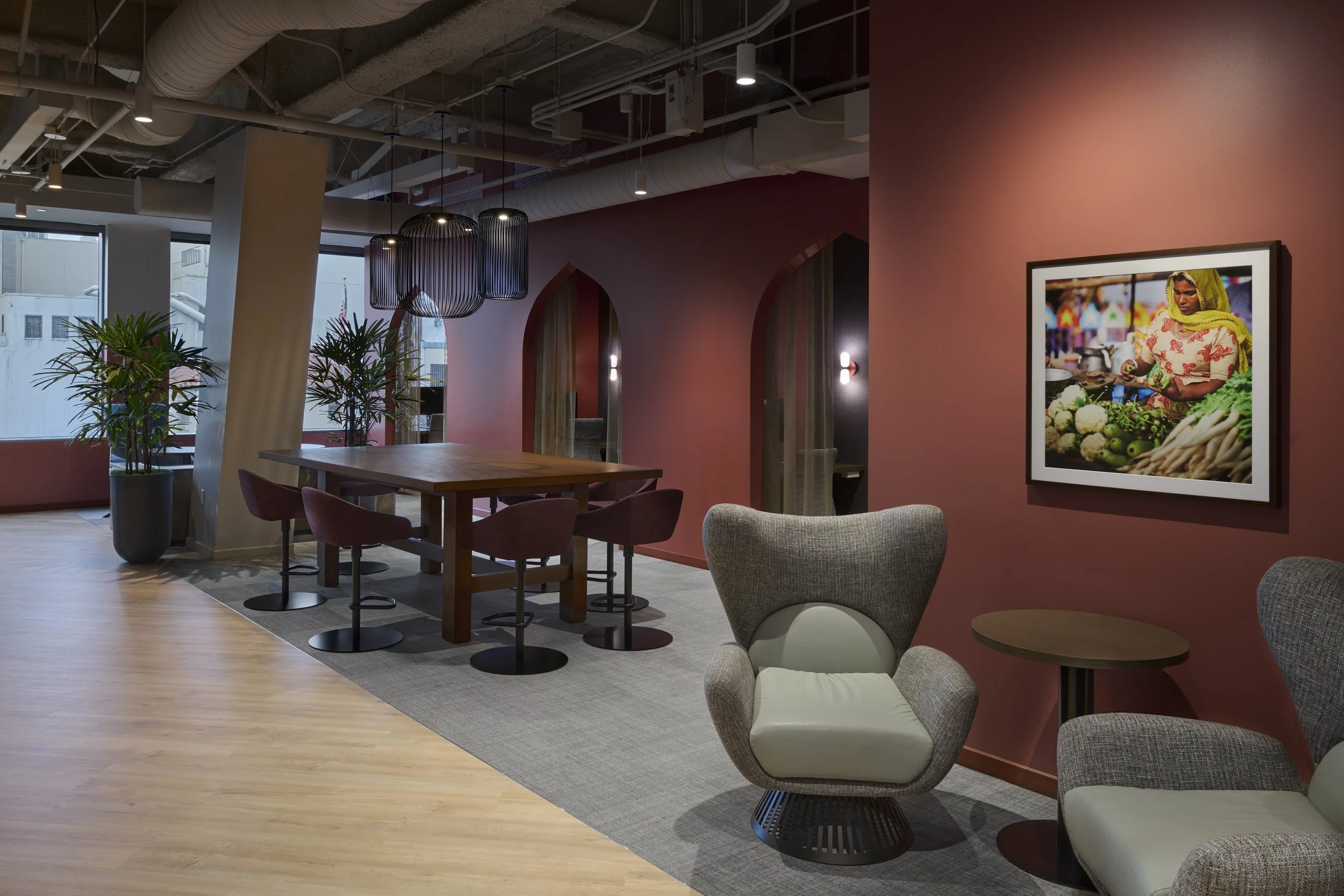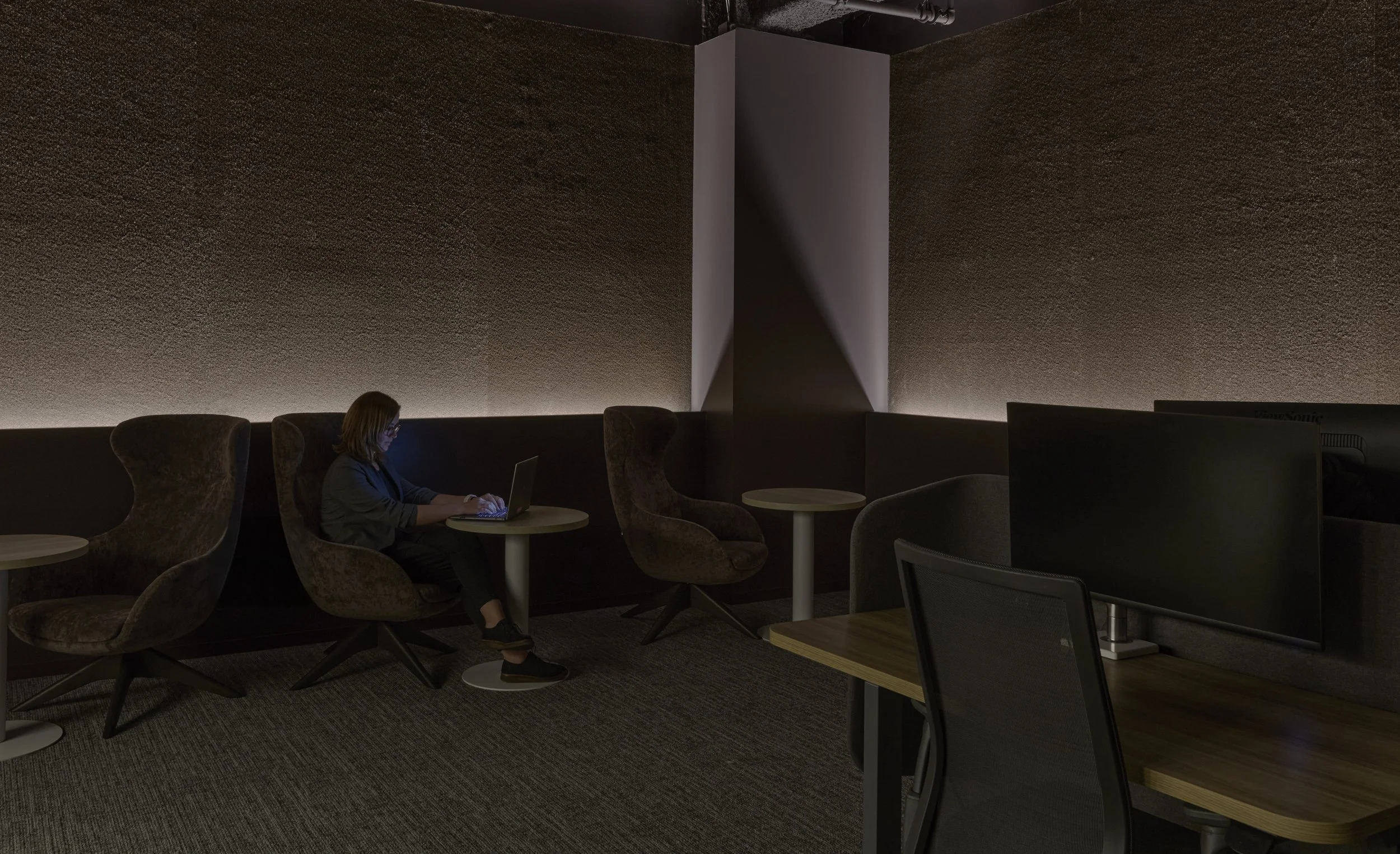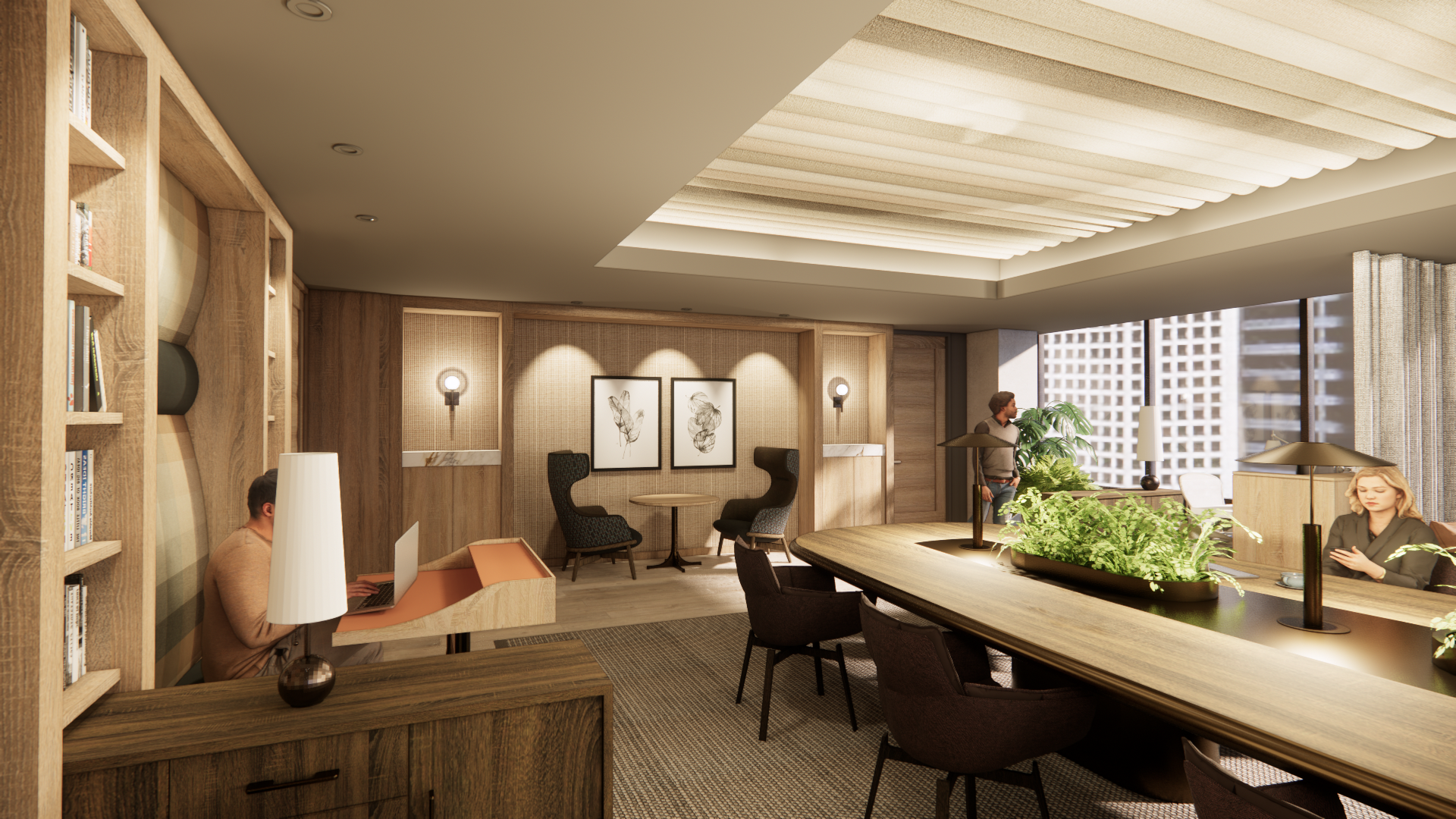WORKPLACE
Office space is one of the more ubiquitous space types in our society, and while often uninspiring, it has the potential to facilitate big ideas and new innovations to make the world better. Amazing workspace designs won’t change the world, but they can empower the people who will.
Tech Firm Global Headquarters
This three floor office TI, located in downtown Seattle, puts the human experience first by providing an array of space types that support focus, collaboration and community so employees can find a place that resonates with what they’re looking for at any given time. The design reflects the client’s focus on global customers and employees by creating spaces that incorporate color, textiles and design styles influenced by global regionalities.
2025. Photography by Chromatics Studio NYC.
Office Case Study Projects
Workspaces in our post-pandemic world are evolving in response to the prevalent use of home offices. For individual focused work, remote work is more productive, but the human side of community, collaboration and connection suffer in an all-remote scenario. By embracing what remote work does well and also focusing on what well-design office space provides, the office can evolve to create environments that enable organizations to flourish in this new paradigm. The following case studies are rooted in the notions of evolution and progress in this new environment.
2024
Office CS1: Community
The community space in an office has always been the heart of an organization’s culture. This is where people gather for morning coffee, lunch and those “water cooler” moments, but it should also be used between those times, creating the “coffee shop” environment internally to support flexible work spots and community connections. Creating an adjacent flex room can be an extension of the main space but also function as a meeting room or even a space to watch the big game or celebrate personal milestones.
Supporting this space as a social and community area first, but also enabling it to be used for large company events creates a flexibility that expands the benefits of a tactile, comfortable, welcoming environment to the whole organization. These spaces should provide many different functions and should always be the most energetic spot in an office.
2024
Office CS2: Collaboration
Collaboration spaces have always been important, and with the shift to include hybrid work, people are coming into the office predominately to meet and work with others. While very important that these spaces are provided in the right numbers to ensure availability, the design must also be flexible, comfortable and technologically easy to ensure they get used. Providing large spaces that can flex in size and function but still feel tactile and welcoming is an experience the multipurpose room should strive for. In addition, the times before and after the meeting are often as important as the meeting itself, and those shoulder times can be supported by a thoughtful hospitality experience in order to provide the quick touchdown, the space for continued discussion, and, of course, coffee.
2024
Office CS3: Focus
Focus spaces are still important though the amount of space they take up is likely less than pre-pandemic. The new approach here is to stretch the concept of focus or individual workspace beyond one-size-fits-all. Vast swaths of workstations are going to pale in comparison to the home office that is bespoke, but curating a variety of workspace types with a variety of visual and spatial tones gives individuals the ability to find a space that suits the work they’re doing at a given time. Creating quiet zones, libraries, and active collaborative zones defines experiences in a way that enables the office to flex based on what an individual needs at a given time.
2024
Management Consulting Firm
Having been in their previous space for more than twenty years, the Seattle office of this global management consulting firm was open to significant evolution in their workspace. Inefficient offices and dysfunctional meeting spaces were impacting the overall team dynamic. The goal was to create a space that facilitated great work while also fostering connection and mentoring within the company, creating a place to be proud of that people would be excited to have as their homebase.
A series of visioning sessions helped define the actual space types needed as well as the primary goals for what the spaces needed to do. In shifting this company to a new approach to working, we studied many planning options. Landing on an approach that alternated collaboration and individual work zones, we provided many different options for meeting rooms to allow for a quick transition from receiving a phone call and having a private room to take it. Creating a variety of workpoint styles throughout the floorplate was important so that individuals could find the space type they needed, such as quiet and alone versus social and active, depending on the work they are doing at a given time. This space is their own unique solution to office, a “garden in the sky” rooted in the Pacific Northwest warmth, greenery and tactility.
Work done while at SkB Architects, 2018
Photography by Hannah Rankin
Seattle Investment Group
West River Group was a growing investment firm in Seattle, and this space was needed to develop a better sense of comradery both with clients and within teams, a space for gathering, socializing and making connections in order to better serve one another. In understanding their culture, the space needed to function just as well for those in shorts and flips flops as for people in three-piece suits, so we developed a “Raw Upscale” vision that inserted elegantly tailored materials, furniture and details within the raw shell of exposed structure and concrete, creating a space that is sophisticated but also casual.
The large social, gathering space is the central hub of the office and takes up approximately half of the square footage. It includes the boardroom and kitchenette as well as a golf simulator and mini-wine tasting room, representing two of the companies WRG invests in. This unique combination of offerings creates a multi-faceted office space that creates a destination that teams and clients all want to have the benefit of, thus facilitating engagement, enjoyment and a stronger culture.
Work done while at SkB Architects, 2019
Photography by Hannah Rankin.
Tech Company
This tech company was young and growing fast, and having been in a cobbled together space that was testing their ability to continue doing their work, they needed a new space that could support their culture and workflow as quickly as possible. Spread over three floors, it was important to support the culture as a whole, so the unique amenities, such as the cafe and the largest meeting rooms, are located on different floors in the areas that had the best light and views to pull people throughout the 3-level office, allowing for impromptu overlaps and breaking down of silos between the teams.
This office is a satellite for a larger company based in California, and enclosed collaboration spaces for video calls to homebase were critical for their workflow. In prioritizing the primary workspaces, we pushed all the enclosed rooms to the interior to give the daylight and views to desks. The culture of the company has an almost dorm-like quality of casual and imprintability, so the design aimed to create a bright and light backdrop that left space for the teams to layer over with their own personalities through art, posters and other personal layers.
Work done while at SkB Architects, 2017
Photography by Hannah Rankin.
Make-A-Wish Seattle
The Make -A-Wish Seattle organization has such a beautiful mission, and we were thrilled to be able to support it. Profiling a number of ‘“wish kid” journeys from beginning to end, the Wish Wall shows examples of granting a wish, visualizing the process for children, their families and donors to make the mission more concrete and accessible. Pushing the general workspace to the window wall around the central meeting spaces, we expanded and relocated the Wish Wall to become a focal point that would be visible from every point in the office, continually reminding everyone of the primary mission of Make-A-Wish, to create life-changing wishes for children with critical illnesses.
We worked with the organization to move from large, inefficient workspace to an open plan with better collaboration and social areas. Working within a minimal budget, we assisted Make -A-Wish to source reclaimed or donated furniture as well as reducing their overall space needs by finding new efficiencies in planning and shifting from offices to workstations.
Work done while at SkB Architects, 2019
Photography by Hannah Rankin.


















































